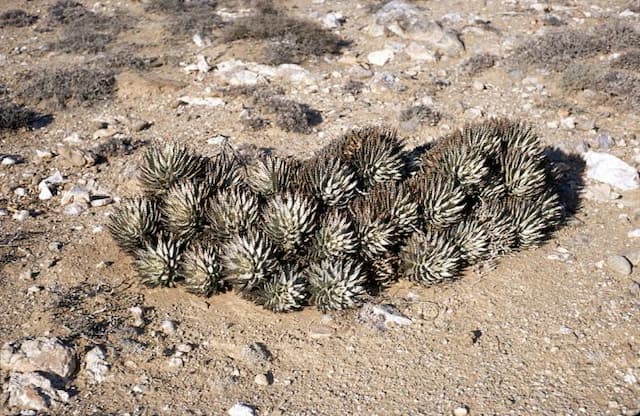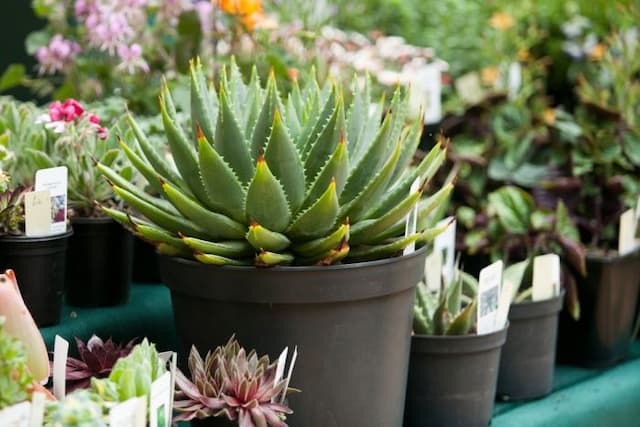Kniphofia 'Bicolor'

ABOUT
The plant commonly known as the Red Hot Poker 'Bicolor' features a striking appearance with vibrant, torch-shaped flowers. These blossoms consist of two distinct colors as implied by the name 'Bicolor'. The bottom portion of each flower spike typically showcases a bright red or orange shade, while the upper sections gradually transition to a creamy yellow or ivory hue. The flowers are densely packed on a vertical spike, creating a bold and eye-catching display. The foliage of the Red Hot Poker 'Bicolor' forms a clump of narrow, grass-like leaves. These leaves are a lush green color and have a linear, slightly arching form, which nicely complements the dramatic flowering spikes. The contrast between the green foliage and the warm-toned flower spikes adds visual interest and makes this plant a popular choice for ornamental gardens. The flowers are known for attracting hummingbirds and other pollinators, which are drawn to their nectar. This perennial is appreciated for its unique flower display and is often used as a focal point in garden beds and borders. Its distinct coloring and bold floral spikes provide a tropical flair to landscapes and are particularly effective when planted en masse for an impressive burst of color.
About this plant
 Names
NamesFamily
Asphodelaceae
Synonyms
Red Hot Poker, Torch Lily, Tritoma
Common names
Kniphofia 'Bicolor'.
 Toxicity
ToxicityTo humans
Red hot poker, which is the common name for Kniphofia 'Bicolor', is not typically considered toxic to humans. There is no widespread documentation indicating serious poisonings from ingesting this plant. However, it's always wise to avoid eating any garden plants unless they are known to be safe and intended for consumption.
To pets
Red hot poker is also not widely reported to be toxic to pets. However, as with humans, it's prudent to prevent pets from ingesting garden plants. Some pets might have individual sensitivities or allergic reactions, and ingestion of plant material can occasionally cause mild stomach upset even if a plant is not truly poisonous.
 Characteristics
CharacteristicsLife cycle
Perennials
Foliage type
Evergreen
Color of leaves
Green
Flower color
Mixed
Height
3 feet 6 inches (1.07 meters)
Spread
2 feet (0.61 meters)
Plant type
Herb
Hardiness zones
5
Native area
Africa
Benefits
 General Benefits
General Benefits- Attracts Wildlife: Kniphofia 'Bicolor', commonly known as Red Hot Poker, attracts bees, butterflies, and hummingbirds, benefiting pollination in the garden.
- Drought Tolerant: Once established, Red Hot Poker can withstand periods of drought, making it suitable for xeriscaping or in regions with water restrictions.
- Easy to Grow: This plant is known for being easy to cultivate, requiring minimal maintenance, which makes it a good choice for novice gardeners.
- Long Blooming Season: Red Hot Poker has a long flowering period that extends through summer and into fall, providing prolonged color in the garden.
- Architectural Structure: The striking vertical form adds an architectural element to garden designs, offering height and visual interest.
- Deer Resistant: Naturally resistant to deer, this plant is ideal for gardens in areas where deer predation is a problem.
- Versatile Use: Red Hot Poker works well in a variety of garden settings including borders, beds, and as a focal point or feature plant.
- Cold Hardy: The plant is quite cold-hardy, able to survive in lower temperatures, which makes it suitable for many climates.
 Medical Properties
Medical PropertiesThis plant is not used for medical purposes.
 Air-purifying Qualities
Air-purifying QualitiesThis plant is not specifically known for air purifying qualities.
 Other Uses
Other Uses- Decorative marshland plants: Kniphofia 'Bicolor', also known as Red Hot Poker, can be used to create a colorful, natural look in artificial marshes or water features due to its tolerance for damp conditions.
- Floral art: The striking flowers of the Red Hot Poker can be used in floral arrangements or modern art installations, with their bold colors providing a strong visual impact.
- Garden borders: Red Hot Poker can serve as an excellent plant for creating borders along garden paths due to its upright growth habit and vibrant flowers that guide the way.
- Pottery adornment: Clay potters may incorporate dried Red Hot Poker flowers into their works to add an organic touch to the pottery’s earthly aesthetic.
- Nectar source in butterfly gardens: Red Hot Poker can be planted in butterfly gardens to attract different butterfly species, as its flowers are rich in nectar.
- Erosion control: The root system of Red Hot Poker can help in preventing soil erosion on slopes or river banks due to its clumping nature.
- Color themes: Red Hot Poker can be used in gardens designed with specific color schemes, as its flowers offer a bright contrast to green foliage or complement warm-colored themes.
- Photography subject: Due to its striking appearance, Red Hot Poker can be an excellent subject for nature photography, offering vibrant colors and unique flower structure to capture.
- Fencing reinforcement: When planted densely, Red Hot Poker can provide a certain level of reinforcement to garden fences, as well as a splash of color.
- Culinary garnish: While not commonly consumed, the flowers of the Red Hot Poker can be used as a decorative garnish for upscale cuisine to add an exotic flair.
Interesting Facts
 Feng Shui
Feng ShuiThe Red Hot Poker is not used in Feng Shui practice.
 Zodiac Sign Compitability
Zodiac Sign CompitabilityThe Red Hot Poker is not used in astrology practice.
 Plant Symbolism
Plant Symbolism- Attraction: Kniphofia 'Bicolor', commonly known as Red Hot Poker, has vibrant, torch-like flowers that symbolize attraction and brightness, drawing both the eye and pollinators to its fiery blooms.
- Standing Out: With its striking appearance, Red Hot Poker symbolizes the idea of standing out or being unique in a crowd, encouraging individuality.
- Strength: The sturdy nature of the plant, which can thrive in harsh conditions, reflects symbols of strength and resilience.
- Flamboyance: Owing to its bold colors, Red Hot Poker is also associated with flamboyance and a showy attitude, embodying exuberance and zest for life.
 Water
WaterRed Hot Poker plants require regular watering, but it is important not to overwater them. A good rule of thumb is to provide about 1 inch of water per week, whether through rainfall or manual watering. They thrive when the soil is allowed to dry out slightly between waterings to prevent root rot. During the growing season, you may increase the amount slightly, but be cautious during winter months to reduce watering to prevent the plant from sitting in soggy soil. Always water at the base of the plant, avoiding overhead watering to minimize leaf and crown diseases.
 Light
LightRed Hot Poker plants perform best in full sunlight where they can receive at least 6 hours of direct light each day. They can tolerate partial shade, but flowering is best in a spot with ample sunlight. Avoid placing them in heavy shade, as this can reduce blooming and make the plants leggy.
 Temperature
TemperatureRed Hot Pokers prefer a temperature range between 50 and 90 degrees Fahrenheit but can tolerate temperatures as low as 14 degrees Fahrenheit. They do best when nighttime temperatures are cooler than daytime temperatures. Ideal conditions are moderate climates with warm days and cooler nights, but they are adaptable to a range of conditions as long as they are not exposed to prolonged freezing temperatures.
 Pruning
PruningPruning Red Hot Pokers involves removing spent flower stalks to encourage more blooms and maintain a neat appearance. This should be done after flowering, typically in late summer or fall. Cut the flower spikes back to the base of the plant. Division of the clumps every 3 to 5 years in the spring can rejuvenate the plants and help maintain vigor.
 Cleaning
CleaningAs needed
 Soil
SoilThe best soil mix for the Red Hot Poker (Kniphofia 'Bicolor') is well-draining, rich in organic matter, with a slightly acidic to neutral pH of 6.0 to 7.0. A mixture of two parts loam, one part peat moss, and one part sand or perlite is suitable to maintain healthy growth.
 Repotting
RepottingRed Hot Poker (Kniphofia 'Bicolor') doesn't need frequent repotting; it is typically repotted every 2-3 years. It's best to repot in the spring when the plant has outgrown its current container and the roots are crowded.
 Humidity & Misting
Humidity & MistingRed Hot Poker (Kniphofia 'Bicolor') tolerates a wide range of humidity levels but prefers conditions that are not excessively humid. Average room humidity is generally sufficient for this plant.
 Suitable locations
Suitable locationsIndoor
Ensure bright light, well-draining soil, and cool temps for indoor Red Hot Poker.
Outdoor
Plant in full sun, amend soil for drainage, and protect from harsh winter.
Hardiness zone
6-9 USDA
 Life cycle
Life cycleThe Kniphofia 'Bicolor', commonly known as Red Hot Poker, begins its life cycle from seed germination, which requires well-drained soil and warmth to sprout. Once germinated, it enters the vegetative stage, growing roots, shoots, and foliage, typically forming a basal rosette of long, narrow leaves. As it matures, the plant enters the flowering stage, producing tall spikes with tubular flowers that exhibit a two-toned color transition—hence its name 'Bicolor'. The peak blooming period occurs in late spring to summer, after which the plant may set seed if pollinators like hummingbirds and bees visit the flowers. As a perennial, after flowering, the Red Hot Poker enters a period of dormancy in the autumn and winter, with the foliage dying back to the ground in colder climates. The plant then regrows from its rootstock or rhizomes the following spring, repeating the cycle.
 Propogation
PropogationPropogation time
Early Spring
The most popular method of propagation for the Kniphofia 'Bicolor', commonly known as Red Hot Poker, is by division. The ideal time to divide this plant is in the spring, just as new growth begins to emerge. To propagate by division, carefully lift the entire clump of the plant out of the ground using a garden fork, trying to keep as much of the root system intact as possible. Gently separate the plant into smaller clumps, making sure each section has at least one growing point or shoot. Replant these divisions immediately at the same depth they were originally growing, spaced about 18 inches (approximately 45 centimeters) apart to allow enough room for growth. Water the newly planted divisions well to help establish them. This method of propagation helps to rejuvenate older clumps that may have become too large or are beginning to die out in the center.









